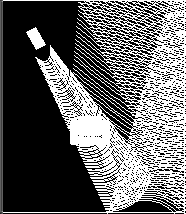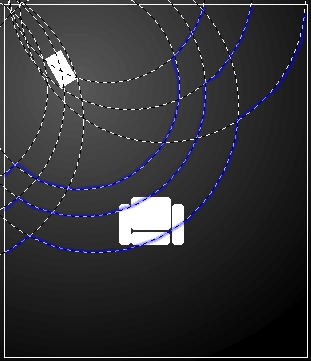|
DIRECT vs. REFLECTED ENERGY by Steve Deckert There
are panel speakers that radiate in a bipolar pattern, Here is what I have found... Lets eliminate electronics from the equation and just focus on the relationship between speakers and your room. It has been my experience that in the categories of imaging, soundstage size & depth, focus, and believability, the relationship between your room and speakers is actually more of a factor than what type of speakers you have. If we look at the most common type of loudspeaker, that being a cabinet with the drivers in an array 90 degrees from the floor and at a parallel angle with the walls as our sample. I will try to paint a picture of what happens. First of all lets reduce our example to a single woofer that plays out to between 1000 and 2000 cycles. Regardless of the size (diameter) of the woofer, it will radiate the majority of itís sound in a beam pattern of 30 degrees or less. Lets say the speaker is 90 dB efficient and in a 14 x 16 listening room. (The exact size of the room is not a critical component in this illustration). Lets only look at one speaker and assume it is set up in the conventional place out away from the walls and pointing at the listening chair centered in the room. This is considered a direct energy listening scenario. However you will only hear direct energy in itís virgin state come from the speaker for the first 10 to 30 milliseconds... after that the bounce off The rear, side and finally front wall will blend across your sound field creating a smearing effect. In this sense there is no such thing really as direct energy unless perhaps you hung your speakers and listening chair from a crane several hundred feet in the air out in the middle of a corn field. Because these three primary reflections are what destroy the focus of your sound stage, it seems to have been assumed that reflections are categorically bad. Dan has made some real advancements in controlling these reflections and absorbing excess energy to minimize this evil. This is done by using quadratic theory diffusers at all the critical reflection points.
By using quadratic diffusers we are able to bust these reflections down and change their pattern of radiation from a single specific angle to a 180 degree horizontal fan. By changing the energy from 30 degrees at the first reflection point to 180 degrees, you can see where the amplitude of that reflected energy would be substantially reduced by as much as 6 times, or 15 dB! At this amplitude your brain hears the reflections as ambiance and does not try to interpret them as part of the primary wave front. Result: Focused perception of a clear image. Since this situation has been modeled and the result is my current listening room, I have come to the conclusion that listening to conventional speakers in a room without this quadratic theory diffusion is to listen in vain. No matter HOW MUCH you spend on gear and speakers you will not achieve the clarity and holographic presentation possible in your playback of the recording. Speakers that have drivers pointing out to the sides or rear often accentuate this problem by reflecting concentrated patterns of energy directly off the nearby walls. In the illustration of a single speaker in a room playing around 1000 cycles there are three problem reflection points that have to be dealt with to get good sound. As you can see it is an aggressive and unnatural pattern.
Recently, I stumbled on to a new d.i.y. idea that I am posting on The web site called The "Radial Loudspeaker". As a result I have started to realize that this may be a design of loudspeaker that actually works WITH a room rather than against it as we've clearly demonstrated in the above discussion about typical loudspeakers. In this model we have a true 360 wavefront almost like that coming off the drum kit. In the radial design, energy is even across a 360 degree plane and 180 degree hemisphere. If substituted for the conventional speaker in our earlier illustrations, you can calculate the following...
In a test, one of these speakers was placed in a room and compared with a conventional speaker on the other channel. The fear was that because your ear only gets 30 degrees or so of the primary wave front, the energy of the speaker would have to be increased by a considerable factor to match the loudness level of the direct radiating speaker on the other channel. Conceivably, this possible side effect could mean 30 / 180 or 6 times The energy to match our conventional speaker. That would be 15 dB, and that would raise the reflected energy in the room by 15 dB making the advantage we thought we had disappear. What happened was rewarding. Since the room corner, i.e.. side and rear wall near the speaker fold the wave fronts into coherently timed graduated fronts, the listening chair actually gets the full energy of the 360 degrees divided by losses and graduated reflection is something like 360 / 1.4 = 257 degrees for a loss of 103 degrees or 28 % which equals just over 1.5 dB. This was confirmed by listening as the conventional speaker had an efficiency of 90.5 and the radial had an efficiency of 95.5. When measured in the room against the 90.5 speaker, the difference was not 5 dB but 3.5 dB! This confirmed the equation and eliminated the fear of losing 15 dB. The only way that could happen is in a very large room or hanging from a string over a corn field. Over The past few days I've been listening to this radial speaker in its unfinished state, and with all the room treatment removed I have as good or better (actually better) performance than using the conventional speakers with a full armament of room treatment.
Decware is a trademark of High Fidelity Engineering
Co. |
 Imagine
the beam of sound coming from your speakers at a sound pressure
of 100 dB. It has a cone shaped pattern of ever expanding
wavefronts at around 30 degrees. It wishes past your ear and
hits the back wall in a circular pattern of around 8 to 10 feet
in diameter. The pattern of sound when it wised past
your head was about 3 to 4 feet in diameter. Since The sound
at your ear was 100 dB at a concentrated diameter of 3 to 4 feet,
The reflection off The back wall will be reduced by 50% power at
a diameter of 8 to 10 feet. This means that reflection that
is now aiming for your side and front walls is at an energy level
of 93dB! Naturally you will hear this reflection as it finally
passes your head and it will be delayed in time enough to confuse
your brain and make it hard to focus or localize the instruments
in the recording.
Imagine
the beam of sound coming from your speakers at a sound pressure
of 100 dB. It has a cone shaped pattern of ever expanding
wavefronts at around 30 degrees. It wishes past your ear and
hits the back wall in a circular pattern of around 8 to 10 feet
in diameter. The pattern of sound when it wised past
your head was about 3 to 4 feet in diameter. Since The sound
at your ear was 100 dB at a concentrated diameter of 3 to 4 feet,
The reflection off The back wall will be reduced by 50% power at
a diameter of 8 to 10 feet. This means that reflection that
is now aiming for your side and front walls is at an energy level
of 93dB! Naturally you will hear this reflection as it finally
passes your head and it will be delayed in time enough to confuse
your brain and make it hard to focus or localize the instruments
in the recording. Lets
look at
Lets
look at  The
wave front passes your head but this time it is already a diameter
exceeding your room size. The reflection point is changed
from a 30 degree 8 to 10 foot diameter standing reflection, to 180
degree graduated non-standing reflection, and hence 15 dB down at
the first reflection point. Also interesting to note is that
the room corner behind your speakers now becomes the first primary
reflection, but since it is graduated it folds to become time coherent
with the primary wave front as shown in blue.
The
wave front passes your head but this time it is already a diameter
exceeding your room size. The reflection point is changed
from a 30 degree 8 to 10 foot diameter standing reflection, to 180
degree graduated non-standing reflection, and hence 15 dB down at
the first reflection point. Also interesting to note is that
the room corner behind your speakers now becomes the first primary
reflection, but since it is graduated it folds to become time coherent
with the primary wave front as shown in blue.